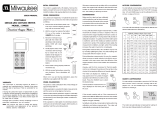
11
Water Action Volunteers – Level 2 Manual Updated January 2016
15. Record the post-calibration D.O. (mg/L) on the calibration log.
16. Look up the calibration chart D.O. value (mg/L) from the table
(available on the next two pages of this manual and as a
laminated sheet in the monitoring kit).
To read the table, find the probe temperature (y-axis)
and the altitude (x-axis) and record the corresponding
D.O. (mg/L) value as the calibration chart D.O. on the
calibration log.
If the difference between the post-calibration D.O. and the calibration chart D.O.
is greater than 0.3 (mg/L), re-calibrate the meter before using in the field.
17. Record any comments about the calibration process in the Comments field on the log.
18. Conduct a post-calibration drift test to verify accuracy of your calibration
If unsuccessful, check on the condition of the probe tip and contact the WAV
coordinator for further instructions.
**Post Calibration Drift
This quality control step must be performed to insure the collection of accurate data. After
calibration, check the meter for drift. This is a check as to how well the meter is holding the
calibration. Leave the meter where you calibrated it (this step is important to insure a stabilized
temperature) and walk away for 5 minutes. Upon returning, the DO percent saturation value
should be within a couple of percent of the calibrated percent saturation value you recorded. If
it has drifted more than a couple of percent, you must remove the cap membrane to check the
condition of the probe. If necessary, refurbish the probe tip according to your instrument’s
manual, and change the solution and membrane (contact the WAV coordinator for further
instructions. Once the refurbishment process is completed, wait one hour before repeating the
calibration procedures listed above (Steps 1-18).
19. After completing a successful calibration and post-calibration drift test, the DO meter
should be left on until the last reading of the day is completed.
20. Once monitoring is complete, moisten the sponge in the calibration chamber and turn
the meter off before storing it in the monitoring kit until the next field event.
Note: If you notice your meter is not calibrating properly, please check for bubbles or tears in
the membrane and replace if necessary. If replacing the membrane does not work, try cleaning
the probe by following instructions in the instrument’s manual (located in the pocket of your
meter case) or contact the WAV coordinator for further instructions or to inquire about a
replacement new meter.




















